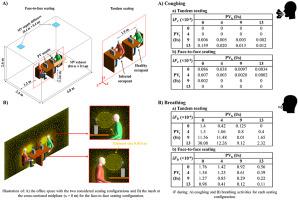Building and Environment ( IF 7.1 ) Pub Date : 2021-02-18 , DOI: 10.1016/j.buildenv.2021.107719 Elvire Katramiz , Nesreen Ghaddar , Kamel Ghali , Douaa Al-Assaad , Saud Ghani

|
While personalized ventilation (PV) has been integrated to enhance inhaled air quality, some studies showed that it can contribute to contaminants' transport indoors. This work investigates the effect of the individual preferences of PV users on potential cross-contamination in an office. Two occupants were using PV, sitting either face to face or back to face (i.e. in tandem). One of the occupants was infecting the office space through two respiratory activities: coughing and breathing. The PV flowrate control ranged between 0 and 13 l/s, ensuring thermal comfort. A 3-D computational fluid dynamics model was developed and experimentally validated in a climatic chamber equipped with one thermal manikin representing the infected person and a heated dummy representing the healthy person. The cross-contamination was assessed using the inhaled intake fraction () index, which is the ratio of the contaminants’ mass inhaled by the healthy person to that exhaled by the infected person. It was found that minimal exposure levels were reached when the infected person used low PV (in the range of 0–4 l/s) for the tandem seating and high PV(in the range of 9–13 l/s) for the face-to-face seating. Furthermore, the average iF for face-to-face seating was 31% lower than that of tandem seating for coughing and 86% for breathing for all possible PV ventilation cases.
中文翻译:

个体控制的个性化通气对呼吸活动引起的交叉污染的影响
虽然集成了个性化通风(PV)以提高吸入空气质量,但一些研究表明,它可以有助于污染物在室内的传输。这项工作调查了PV用户的个人偏好对办公室中潜在的交叉污染的影响。两名乘员使用PV,面对面或背对背(即一前一后)坐着。其中一位居住者正在通过两次呼吸活动(咳嗽和呼吸)来感染办公室。PV流量控制范围为0到13 l / s,确保了热舒适性。在装备有一个代表被感染者的热暖体假人和代表健康人的被加热的假人的气候室内,开发了一个3-D计算流体动力学模型并进行了实验验证。)指数,即健康人吸入的污染物与感染者呼出的污染物之比。研究发现,当被感染者串联座位使用低PV(0–4 l / s范围)和面部使用高PV(9–13 l / s范围)时,暴露水平达到最低。面对面的座位。此外,在所有可能的PV通气情况下,面对面就座的平均iF均比串联坐位的平均iF低32%,而咳嗽和呼吸的平均iF均低86%。











































 京公网安备 11010802027423号
京公网安备 11010802027423号